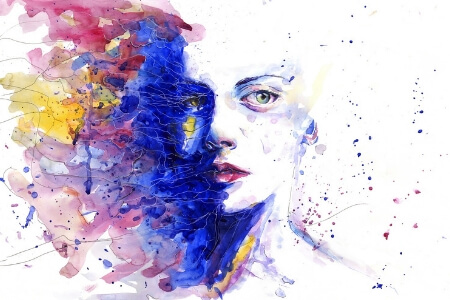- Home
- Migraine Symptoms
- Blurred Vision and Headache
Magnesium Deficient = More Migraine Attacks
Science confirms this hidden trigger.
Get all 7 forms your body actually absorbs in one bottle.
🎁Save 10% with my code!
Magnesium Deficient = More Migraine Attacks
Science confirms this hidden trigger. Get all 7 forms your body actually absorbs in one bottle +
🎁Save 10% with my code!
Blurred Vision and Headache: 7 Symptoms You Need To Know About
 Does blurred vision and headache ruin your life? These symptoms might help explain why.
Does blurred vision and headache ruin your life? These symptoms might help explain why.
There are lots of reasons why you might have blurred vision and headache. The more serious ones are: a brain tumor, head injury, stroke, low or high blood pressure. There are also various eye diseases that could cause your vision to become blurry. It’s also one of the most common symptoms of headaches and migraine.
And these visual disturbances can occur before, during and after the headache or pain phase of an attack.

Persistent and Repetitive Blurred Vision and Headache
Are your blurred vision and headache disturbances persistent and repetitive?
These disturbances are typically episodic and associated with the head pain phase of a migraine attack. However, you might find that the visual sensitivities wreak more havoc than the pain phase.
Visual symptoms can be dominant due to "frequency (migraine aura status), duration (persistent migraine aura and other persistent positive visual phenomena), or complexity (visual snow syndrome)." [5]
We will look at a couple of these syndromes that are rarer and more challenging, so you can take this information to your doctor and be aware of what to watch for.
How is the visual system involved?
Your body’s visual system is involved in your migraine attacks in different ways. You are probably aware of the visual auras that can come before an attack, but what you might not know yet is that they also consist of categories: positive, negative, and distorted visual symptoms.
Cortical spreading depression is currently believed to be the function that underlies it. "Even in migraine without aura, vision is not totally excluded given that one of the major criteria for the diagnosis of migraine is photophobia." [3]
For example, in persistent visual aura, many migraine patients refer to symptoms as visual snow and television static. [3]
In retinal migraine one-sided decreased vision or complete visual loss occurs. [3]
Ophthalmoplegic migraine symptoms are characterized by "palsy of one among the three ocular motor nerves." [3]
The 7 Visual Symptoms of Migraine Headaches You Should Know About
1. Migraine Aura
Approximately one-third of people living with migraine also experience an aura with all or some of their attacks. The migraine aura is the second stage of the migraine process following the prodrome. According to the International Classification of Headache Disorders (ICHD), migraine aura is also a specific sub-type of migraine with its own diagnostic criteria. [1]
The aura is most commonly known for the distorted visual problems, but this phase can include other sensory disturbances such as nausea or touch sensitivity.
New research is looking at using the term "migraine with prolonged aura" as a useful bridge between "typical aura and persistent aura." But further studies would be necessary to assess whether changing the classification category would eventually help diagnose or treat patients more effectively. [5]
Here are the common symptoms of the aura phase:
- light flashes, spots, or zigzag lines *
- loss of vision or blind spots **
- "fractured vision" (like looking through cracked glass) ***
- change in color perception ***
- Alice in Wonderland Syndrome (a perceptual distortion of the size or shape of an object - commonly experienced by children). [1] ***
These are the three distinct symptom categories of aura: positive*, negative** and distorted vision symptoms.*** [1]
2. Retinal Migraine
This is a specific type of migraine with aura that has similar symptoms to a classic migraine's typical aura, but it only affects one eye. Retinal migraine has positive aura symptoms such as: flashing lights, zigzag patterns, etc. as well as negative symptoms like: partial blindness and or blind spots. It is common for the resulting headache phase of an attack to be concentrated on the same side of the head as the visual disturbance(s).
Note: Other common names used are: eye migraine, "ophthalmic, optical or ocular migraine to describe these symptoms that affect one eye; however, retinal migraine is the only subtype of migraine that is officially recognized by the ICHD." [1]
3. Vertigo and Dizziness
Do you get dizzy before or during an attack? How about after?
Vertigo, nausea and dizziness can occur at any time even when you’re not having an attack if you are prone to vestibular migraine. The "ICHD considers vertigo an episodic syndrome associated with migraine attacks instead of a primary headache disorder." [1]
You might experience the room moving without it actually moving or feel like you are on the ocean. Spinning and losing your balance are typical symptoms of this syndrome.
The length of time for the whole episode can vary greatly. The "dizziness can persist anywhere from a few seconds in duration to days or even weeks, but it differs from aura in that it usually lasts more than an hour." [1]
I’ve written more about vestibular migraine here - Vestibular Migraine.
My #1 Choice in Magnesium Supplements
4. Binocular Blindness Syndrome
From blurred vision and headache to temporary blindness.
Do you ever lose vision in both eyes during a migraine attack or headache?
This can be associated to the aura phase of a migraine, or for some, it can occur with no previous history of aura. There are few studies to date on this syndrome.
One study of 383 female patients at the "Geisinger Headache Center in Pennsylvania showed that this type of temporary blindness occurred instantaneously during the headache phase of a migraine attack" in 1.6% (6) patients.[1] So, instantly versus slow onset.
It also varied in frequency and duration. One patient experienced it with 50% of her attacks while others only dealt with it once. Duration also differed from patient to patient. Varying results revealed it could last for only a few seconds; between 2 – 10 minutes; from 60 – 120 minutes. [2]
5. Light Sensitivity and Photophobia
Does light make you cringe even when you are not experiencing blurred vision and headache?
If you get migraines, which you must do or you wouldn’t be here, you may have developed sensitivity to light. This is called photophobia.
"Conservative estimates suggest that 80 to 90% of migraine patients are affected by light sensitivity, making it among the most common symptoms of the headache disorder. It is also one of the distinguishing criteria for diagnosing migraine." [1]
This can also be one of your triggers.
Glare from computer screen, sunlight, any brightness or exposure to certain types of light (e.g. fluorescent) can trigger an attack.
Aura and light sensitivity can often get confused. But they are different. One can lead to the pain phase, or not, and one triggers the pain phase. Do you know which is which? It can be hard to tell.
Another way to distinguish the difference could be to say that light sensitivity can impact anyone causing blurred vision and headache, even if you get migraine without aura.
The visual aura you get from just light exposure may or may not manifest for you as pain or a painful sensitivity. It may just present as irritating. But it’s also a sign that the migraine phases have started. So when exposure to light actually initiates the migraine episode, it can lead to the next phase of a migraine which is a visual aura.
So - an aura leads to the pain phase, and light sensitivity can be a trigger for you.
You can read more about that here - Stages of Migraine: Prodrome, Aura, Head pain, Recovery.
Now this is important… the experts stress not to avoid light.
Disappearing into a nice dark room during an attack is acceptable as a temporary option for relief, “but you risk dark adapting your eyes if you shield them from all forms of light - such as by wearing sunglasses indoors - as a preventative measure.”
TheraSpecs precision-tinted glasses are one of your options available to help alleviate painful photophobia without compounding this risk.
Here Are My Top 3 Recommendations:
As an Amazon Associate, I earn from qualifying purchases - affiliate disclosure.
Here’s a more detailed explanation of migraine-related light sensitivity – Migraine Light Sensitivity: How To Reduce It.
6. Visual Snow Syndrome
Patients with "visual snow" suffer from continuous TV-static-like tiny flickering dots in the entire visual field. Most patients describe a syndrome with additional visual symptoms of the following categories: palinopsia ("afterimages" and "trailing"), entopic phenomena arising from the optic apparatus itself (floaters, blue field entoptic phenomenon, photopsia, self-light of the eye), photophobia, nyctalopia (impaired night vision), as well as the non-visual symptom tinnitus.
~ Schankin, Maniyar, Sprenger, et al. [4]
This is a unique syndrome that often gets mistaken for migraine with aura, but it is its own unique syndrome. Migraine (with or without aura) is not the only trigger for episodes of Visual Snow, it can also come with headaches or be aggravated by migraine medications like triptans and other prophylactics. [1]
It can manifest in other ways too, so be aware of those after images, trailing floaters, diminished night vision, and tinnitus... blurred vision and headache!
My #1 Choice in Magnesium Supplements
7. Dry Eyes vs. Dry Eye Syndrome
Research has uncovered that migraine sufferers are three times more likely to have dry eyes as a symptom, even if they’re not diagnosed with dry eye syndrome (Blepharitis). [1]
Your blurred vision and headache would fall into this category as well.
Your dry eye symptoms might look like:
- stinging, burning
- general discomfort in both eyes
- redness and irritated eyelids
- blurry vision
- increased light sensitivity (caused by and can trigger migraine)
Blepharitis is a long-term (chronic) condition. It is, by definition, inflammation of the eyelid and is not a sight-threatening problem. But it can result in decreased vision, which can come and go. The symptoms of chronic blepharitis tend to come and go as well.
You may have periods of remission (a pause in symptoms) followed by periods of exacerbations (a flare-up). It usually affects both eyes equally.
This dry eye syndrome can't usually be cured, but the symptoms can be controlled with good eyelid hygiene. [6]
Here are the symptoms I notice most with mine:
- appearance of the eye tissue wrinkling inside the eye
- itchy eyes and eye lids
- crusty eyelashes upon waking
- flaky skin around eyes (like dandruff)
Make sure to discuss your blurred vision and headache with your doctor or specialist if you think your migraine or headaches may also be causing dry eye symptoms. There are numerous over-the-counter or prescription drops to help treat it.
WANT MORE TIPS? Subscribe to my newsletter and follow along on Facebook and Pinterest for all of the latest updates.
MIGRAINE SYMPTOMS Related Articles
How to be more MIGRAINE SAVVY right now...
Blurred Vision and Headache References - Accessed Feb. 12, 2019 Updated Feb. 19, 2021.
1. Bullock, G. (2017) 6 Visual Symptoms and Disturbances of Migraine. Available [online] at: https://www.theraspecs.com/blog/the-many-visual-symptoms-and-disturbances-of-migraine/
2. Rozen T. Migraine With Binocular Blindness. Headache. 2011;51(10):1529-1536. Cited in Bullock [1]. Available [online] at: https://www.ncbi.nlm.nih.gov/pubmed/21812773
3. Marzoli SB1, Criscuoli A2. The role of visual system in migraine. Neurol Sci. 2017 May;38(Suppl 1):99-102. doi: 10.1007/s10072-017-2890-0.
4. Schankin CJ1, Maniyar FH, Sprenger T, Chou DE, Eller M, Goadsby PJ. The relation between migraine, typical migraine aura and "visual snow". Headache. 2014 Jun;54(6):957-66. doi: 10.1111/head.12378. Epub 2014 May 9.
5. Christoph J. Schankin MD, PhD Michele Viana MD Peter J. Goadsby MD, PhD. Persistent and Repetitive Visual Disturbances in Migraine: A Review. First published: 07 October 2016 https://doi.org/10.1111/head.12946
6. Stuart A., EyeNet Magazine (2012) Managing Blepharitis: Tried-and-True and New Approaches. Available [online] at: https://www.aao.org/eyenet/article/managing-blepharitis-tried-true-new-approaches




















